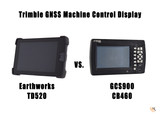Shop Now: https://4kequipment.com/trimble-machine-control/
Trimble offers two notable systems for construction and earthmoving projects: the Trimble GCS900 Grade Control System and the Trimble Earthworks Grade Control Platform. Both systems are designed to enhance productivity and accuracy in construction and earthmoving operations, but they cater to different needs and feature varying levels of technology and user interface design. Here's a comparative overview of both systems:
Trimble GCS900 Grade Control System
Key Features:
- Versatility: Compatible with a wide range of construction equipment including dozers, graders, excavators, scrapers, and compactors. It can be configured for either 2D or 3D projects depending on the requirements.
- GNSS and Laser Technology: Utilizes both GPS and laser technologies to provide accurate grading and leveling.
- User Interface: Features a more traditional user interface with robust controls and display options that experienced operators may be familiar with.
Advantages:
- Flexibility in Configuration: Can switch between 2D and 3D configurations, which allows for use in various phases of construction, from initial earthmoving to fine grading.
- Proven Technology: Established technology that has been field-tested and refined over many years, ensuring reliability and effectiveness.
Applications:
- Ideal for projects that require a high degree of adaptability and can benefit from the established, reliable technology. It suits a broad range of construction activities from large scale earthmoving to precise grading.
Trimble Earthworks Grade Control Platform
Key Features:
- Advanced Technology: Incorporates the latest in technology with more sophisticated sensors and algorithms. This system is designed to offer more automated control capabilities.
- Touchscreen Interface: Features a modern, intuitive touchscreen interface that can significantly enhance user interaction and ease of use.
- Real-Time Data: Provides real-time feedback and allows operators to make adjustments on the fly, enhancing efficiency and reducing the need for rework.
Advantages:
- Increased Accuracy and Productivity: The automation and real-time control significantly increase accuracy and productivity on the job site.
- User-Friendly: The modern interface and the use of mobile devices for control and monitoring make it particularly user-friendly, especially for new operators.
Applications:
- Best for more technologically advanced projects where high precision and efficiency are critical. It's particularly suitable for modern construction environments that demand quick adaptability and operational efficiency.
Choosing Between GCS900 and Earthworks
The choice between Trimble GCS900 and Trimble Earthworks often depends on several factors:
- Project Requirements: The complexity and precision requirements of the project may dictate the choice. Earthworks is preferable for projects needing higher precision and efficiency through automation.
- Operator Preference and Experience: GCS900 might be preferred by operators who are accustomed to traditional systems and may find its interface and controls more familiar. Earthworks, however, might be more suitable for newer operators or those comfortable with modern technology interfaces.
- Budget Considerations: Earthworks might involve a higher upfront investment due to its advanced features and capabilities.
In summary, Trimble GCS900 offers traditional reliability and flexibility, making it suitable for a wide range of construction needs, while Trimble Earthworks provides a more modern, automated, and user-friendly experience for high-efficiency and precision-demanding projects.

